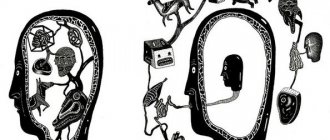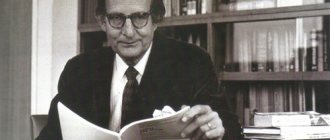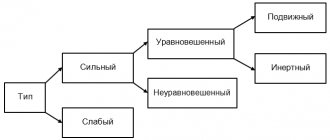Quite often, “accidents” (which, as we know, are not accidental) play an important role in a person’s life. For example, having chosen the road to escape from fate, we meet it there. And the one who finds the answer to the question of why this happens remains in people’s memory for a long time.
Largely due to finding non-standard answers to extravagant questions, the scientist Eysenck Hans Jurgen was remembered.
Eysenck's childhood and adolescence
All the most interesting things that can later play a key role in a person’s development happen in childhood. Hans Jürgen Eysenck (03/04/1916 – 09/04/1997) was the child of the “cultural intelligentsia” - both his mother and father were actors. Ruth Werner (under the pseudonym Helga Molander) shone on silent film screens, and Anton Edward Eysenck combined singing and acting. The parents had no time left for the child. And two years later they separated, and Hans Jurgen Eysenck was sent to be raised by his maternal grandmother.
From the memoirs of Hans Eysenck one can learn that the little grandson was always given complete freedom of action, and his pranks were treated leniently. Perhaps that is why the boy “tried everything for strength and authenticity.”
Hans Jurgen Eysenck was known in all circles for his “rebellious” style of behavior. Although it was precisely thanks to this feature that scientific ideas were put forward and their validity was proven.
Dream interpretation
This chapter literally repeats the title of Freud's work. “According to the theory of Freud and many others...dreams do not reveal anything about the future” [1, P. 438]. And they are dedicated exclusively to the past and present, in symbolic form. Here, too, one cannot do without a critical approach to psychoanalysis: Freud believed that in a dream everything has meaning (but this idea existed in culture for a long time, and he only popularized it), everything is connected with the satisfaction of desire (and this is also not original), and consciously suppressed (and only this thought is truly Freud’s discovery (see: [1, p. 439]). And the method of verbal associations, as Eysenck proves, is rather a discovery of F. Galton. In addition, the legitimacy of the symbolic interpretation of dreams has not been proven ( Thus, Hall argued that the same action causes different reactions and associations in different people).
Moving to England
Hans became aware of his uniqueness while still at school: he often liked to demonstrate the superiority of his knowledge of a subject over the knowledge of teachers who graduated from military universities. Being the first athlete at school, he openly expressed his negative impressions of the Nazi rally and Hitler speaking at it. His comrades, in agreement, beat him with a crowd. However, this did not bother the future Doctor of Philosophy. The next day, Hans caught his offenders one by one and inflicted “justice.” True, the ability to take a punch did not help the young man when entering the University of Berlin.
For the first time in his life, the young man was faced with a choice: joining the Nazi secret police and entering the university or having his candidacy rejected as a student. Hans Jurgen Eysenck leaves Germany and goes to England.
Studies
He received his education in European private schools. Often loving to demonstrate his superior knowledge over teachers who graduated from military universities, he was also superior to many physically. So, after he expressed his disapproval of fascism and Hitler in particular, the school staff beat him up with almost the entire staff. However, his answer to the offenders was also not long in coming. The teachers had difficulty hushing up the scandal, which threatened to turn into a massacre.
After graduating from high school, he was accepted into the Faculty of Philosophy at the University of Berlin. However, there they persistently hinted at the need to join the SS, so his mother and stepfather (a Jewish director) decided that it would be better to leave the country. At the University of Dijon, in France, he studied history and literature, and the next year he entered the University of London, in England. There Eysenck asked to study at the Faculty of Physics, but after a course in history and philosophy he could only be accepted into psychology. He agreed to agree, but caused quite a scandal in the process.
Thanks more to his ability to talk on any topic and self-confidence than to actual knowledge, he graduated from the university with honors and received a red diploma. Professors dubbed him “the hope of future science” and gave him good recommendations, and several private colleges even invited him to give lectures.
Professional development
The move adjusted Hans's plans. Dreams of entering the physics department of the University of London did not come true for a number of reasons. However, not wanting to lose a whole year due to non-compliance with the requirements, Eysenck enrolls in a psychology course. In 1938, the young psychologist received a bachelor's degree. And in 1940 he became a Doctor of Philosophy.
From the same year, Hans began working at Mill Hill Hospital, accepting patients with various psychiatric problems. It should be noted that up to this point Eysenck had not had any psychiatric or clinical practice. This did not mean that the young Ph.D. would succumb to difficulties. Hans considers the criteria and categories of clinical diagnosis unsatisfactory and finds it possible to apply only the factor theories of personality that were being developed at that time in practice. Thanks to this research, extensive practice and tireless observations, the theory of personality formation was formalized in the book “Dimensions of Personality” (1947).
Factor analysis is the contribution of Eysenck Hans Jurgen to psychology and partly psychiatry of that time. He noticed that two main factors stand out when describing personal qualities: neuroticism on the one hand and extraversion (introversion) on the other. This idea will receive its final form in 1970.
In the post-war years, Eysenck continued to work in the psychiatric department as director and after some time became a teacher at the University of London.
In order to study the psychiatric practice of Western colleagues, in 1949 he went to work as a visiting professor in Pennsylvania. Not surprisingly, clinical psychology training programs in the United States and Canada were characterized by Hans as “unscientific.”
In 1950, Eysenck returned to Europe.
Activity
“When I first started studying psychology, it was completely defective. Now her reputation has been completely restored thanks to my work,” Hans Eysenck.
Returning to Germany, he became very interested in the Nazi experiments in the field of genetics and even set out to measure human intelligence. At lectures one could often see him surrounded by a variety of different measuring instruments, and Eysenck himself was nicknamed “the thermometer man” by his colleagues. As an argument, he talked about white tree crickets, adding the number 40 to the number of chirps in 15 seconds, you can get the air temperature in Fahrenheit.
«White tree crickets are rare, difficult to catch, and fit poorly into the general system of physical laws on which our measurement system is based. Therefore, the invention of the thermometer was recognized by everyone as a significant achievement. And to measure intelligence we will come up with our own thermometer
“,” he said.
Returning to England, he wrote a series of articles imbued with a fascist spirit, and his attitude towards democracy was nothing short of contempt. It is quite natural that they hated him for this, and sometimes they simply considered him crazy.
When World War II began, he was sent to Mill Hill Military Psychiatric Hospital, where he worked as an experimental psychologist, working with military personnel who had suffered severe stress and trauma. Without any practice in this matter, he still considered the criteria and categories of clinical diagnostics of that time unsatisfactory and began to apply the factor theories of personality that he was developing at that time. It was his work at that hospital that allowed him to write his book, “Dimensions of Personality.”
Remaining at the hospital after the war, in 1946 he founded the Department of Psychology at the Institute of Psychiatry at Maudsley and Bethlem Hospitals, the head of which he remained until 1955. At the same time, he lectured on psychology at the University of London, and was a consulting professor at more than one university in the United States. Easily gaining popularity through scathing criticism of his common idol, Sigmund Freud, who had already died at that time, his works were already being actively published at that time.
«Psychotherapy is just rubbish. A patient with a sexual disorder came to me, I recommended him to watch one film - and everything went away for him. Patients with neuroses recover on their own over time
“,” said Eysenck.
Not having a high opinion of traditional types of psychotherapy, he prescribed electric shock and psychotropic drugs that cause suffocation to his patients, and advised hysterical children to be locked alone in a room for 10 minutes. Despite its effectiveness, he was accused of cruelty and fascist methods of treatment.
In 1955, Eysenck received a position as a professor at the Institute of Psychology at the University of London, and in 1983, having already become an honorary professor, he retired. Having reworked tests for children created by the French psychologist A. Binet, he applied them to adults - as a result, he received a method for determining intelligence quotient (IQ). His technique gained great popularity and was used everywhere, and Eysenck himself traveled a lot and became a wealthy man.
In his 1971 paper, "Race, Intelligence, and Education," he introduced the idea that Blacks, compared to Caucasians, have an IQ 15 points lower because of their genetic makeup. His article caused a strong reaction, including: his book “The IQ Controversy” was refused to be distributed in America because booksellers were threatened with violence and arson, and newspapers refused to publish reviews of it. Eysenck himself was beaten by a crowd of students in 1973, before he even had time to begin his lecture at the Sorbonne. However, he did not bring any charges against them.
In the 1970s, he published a number of articles on the connection between various diseases and personality types. In them, he stated that lung cancer is not caused by smoking, but by personality disorders characterized by an incorrect reaction to stress or even an inability to express emotions. Heart diseases are characteristic of angry, aggressive and hostile people. But, in his opinion, brawlers and people with a quarrelsome character are most likely to recover.
In 1980 he founded the journal Personality and Individual Differences, and from 1983-1985 he served as president of the International Society for Individual Differences. In the early 1990s, the American tobacco industrialist funded Eysenck's research, which confirmed his hypotheses. Due to the reluctance of the scientific community to accept the results of his research, he performed this experiment on himself. Tested with electrodes, Isaac showed no reaction - no fear, no depression, no rage. At some point they even decided that the problem was faulty equipment.
Eysenck's death on September 4, 1997, caused by brain cancer, fully confirmed his theory about the origin of diseases.
Becoming a scientist
What contribution did Eysenck Hans Jürgen make to science? Currently, few people think about the emergence of such familiar concepts and phenomena. However, some of them began to exist not so long ago. Eysenck watched with bated breath, as far as possible, the genetic experiments carried out at Ahnenerbe. The young scientist had the opportunity to conduct brain research himself with the intention of identifying a correlation between brain size and human intelligence. Such experiments have so far not led anyone to establish any patterns, but Hans needed to make sure of this.
Border zones of science: hypnosis and suggestibility
In the second part of his work, Eysenck examines the phenomenon of hypnosis. As in the case of psychoanalysis, many patients claim improvements after sessions, but it is not possible to verify these results (experiments of Mesmer, Braid, Bernheim, Libo, Charcot). The pattern is as follows: “the simpler the task, the greater the improvement, and vice versa, the more complex the task, the smaller the improvement will be” [1, P. 335]. If we turn to Freud, he himself believed that the degree of immersion in a hypnotic state is directly related to the degree of transference. The concept of “transference” is interpreted in Eysenck’s book in a broader sense than Freud himself understood.
Bird's influence on the formation of Eysenck's concepts
The young scientist’s scientific supervisor was Cyril Lodovik. He is known for his categoricalness in the matter of intellectual development. From his point of view, intellectual abilities are an innate property (like eye color). The proof was provided by studies based on Binet-Simon tests. Eyewitnesses claimed that Cyril was a good mathematician and was trying to calculate the exact distribution of innate and acquired intelligence factors.
Burt was responsible for the development of the theory of the two-factor structure of intelligence (the idea itself was expressed by Charles Spearman). Subsequently, Cyril’s persistent attribution of the authorship of this concept to himself allowed some critics to speak out about the scientist’s ill health (he was considered paranoid).
Much, if not all, of Burt's writings can be found in Eysenck's statements. We can say that Hans brought the system to perfection. Today it is known throughout the world as an IQ test.
Famous questionnaires of the psychologist
Studying in detail the influence of environment and heredity on intelligence, as well as the structure and types of personality, Eysenck created many tests in the form of questionnaires that help to conduct a complete diagnosis of a person’s mental state in order to get a general idea of his character, actions, psychological reactions and propensity for one or another. a different model of behavior.
Among others, the Eysenck self-esteem test is often used. For the most part, such questionnaires are used in educational institutions. Self-assessment of mental states according to Eysenck allows us to identify the level of self-esteem of students, as well as determine the level of four main mental states:
- Anxiety.
- Aggressiveness
- Frustration.
- Rigidity.
The test itself consists of 40 questions specific to each specific condition. The respondents are offered three answer options: “yes”, “no” and “sometimes”. After processing the test results, you can get a very plausible picture of the test subject’s condition and understand how adequate his self-esteem is.
In addition, Eysenck’s theory of different personality types, built on the concept of a hierarchical model of human personality (where the highest level is represented by superfactors, and the lower level by specific thoughts and actions of a person), allowed the scientist to create a personality questionnaire (a test for determining temperament). It is a list of questions that relate to the behavioral characteristics of the person being directly assessed.
This technique of G. Eysenck was developed by the scientist based on the results of his tests, in which more than 30,000 people participated. Initially, the subjects simply answered questions (there were 2 options of 57 questions each), but later Hans Eysenck, together with Sibylle Eysenck, developed a new assessment method, in which, in addition to questions that were used to diagnose a person’s behavioral characteristics and a “lie” scale, there were and additional ones - on the definition of psychotism. In total, a person had to give 101 answers.
We recommend: What is character?
Both the original and the later proposed methods include questions that are absolutely relevant to the three main factors of personality structure, and the “lie” scale in both the first and second cases helps to identify the respondent’s tendency to falsify answers.
By the way, the initial test, which allows you to determine the type of temperament, is more popular than the questionnaire compiled later. And this is explained by the number of questions, of which in the first case there are only 57.
Ph.D. Family
The personal life of Hans Jurgen Eysenck was not as controversial as his social and scientific life. In 1938, the psychologist married Margaret Davis, who was also a student at the University of London, but in the department of mathematics. A native of Canada was married to Eysenck until 1950. The son Michael, born in this marriage, subsequently became a famous author of books on psychology, and the book “A Study of the Human Psyche” became a joint work of son and father.
Immediately after his divorce from Margaret, Hans marries Sybil Rostal (whom he met while traveling in Philadelphia). Daughter of violinist Max Rostal, psychologist, mother of four children (the couple had 3 boys and a girl)
Together with her husband, she published several books (mostly modified tests). Eysenck's wife and children, Hans Jurgen, supported him in everything and were his only outlet, while the entire scientific world was raging. The famous psychologist never considered family relationships from the point of view of Freud's psychoanalysis. In addition, he spoke unequivocally about the Oedipus complex. In Hans Jürgen’s short biography of Eysenck, family relationships are almost always ignored, but fruitful joint work with members of the household speaks of the mutual understanding and support that reigned in the scientist’s family.
Social attitudes
This is also an important issue that affects the development of society in the broadest sense. Stereotypes are something we encounter every day. And their modality (positive or negative) is associated with established subjective relationships. So, speaking about anti-Semitism, Eysenck gives a test for attitudes towards Jews and along the way proves that the basis of any stereotype is emotion - which means that no evidence or appeals to the mind work. Likewise, public opinion polls are important and in demand, especially now, but the methodology and correctness of their preparation leave much to be desired: errors in the wording of answers and factors influencing the answers are revealed. That is, the question of the validity of the survey is very important (it is interesting that Eysenck himself was criticized for the vagueness, or even incorrectness, of the answers and wording in his intelligence tests).
Scientist's legacy
Eysenck's extraordinary personality manifested itself in everything from defending his scientific beliefs to provocative behavior (for which he was nicknamed the "terrible child of the seventies"). The scientist's legacy includes 45 books and more than 600 articles.
He founded and edited such journals as Behavior Research and Therapy and Personality and Individual Differences. The basis of Eysenck's concept was such personality factors as extraversion - introversion and neuroticism - stability. After some time, a third type of personality dimension appeared in theory (psychotism - the strength of the superego), with the assumption that this is a genetic predisposition to personality development along a psychotic or psychopathic line.
Based on the models of behavioral reactions developed by the psychologist, a method of personality correction was proposed - aversive psychotherapy (or aversion therapy). Many centers for helping people with drug addiction use this type of therapy as their main one.
Personality, smoking and illness
Eysenck's other important initiative after his retirement was to study the relationship between temperament and physical health. In the early 1960s, a collaboration with oncologist David Kissen suggested a link between cancer and personality. Eysenck soon attracted more attention by stating that the causative role of cigarettes in cancer had not been convincingly proven. Eysenck received a boost of criticism from public health advocates as the anti-smoking message became more visible and compelling in the late 1960s.
Eysenck revisited the issue in the early 1980s and presented new genetic evidence linking personality, smoking and disease. In a series of papers in the late 1980s and early 1990s, Eysenck and the little-known Yugoslav researcher Ronald Grossart-Maticek reported a series of longitudinal studies apparently demonstrating a striking link between personality types and cancer and coronary heart disease. Although Eysenck did not organize these studies, his contributions helped fine-tune the presentation and analysis. There have been a number of interventions suggesting that psychotherapy can have surprisingly beneficial effects for cancer patients and people with unhealthy lifestyles. While the scope and ambition of these investigations was welcomed, critics complained of a lack of methodological control and descriptive detail. Some, such as Anthony Pelosi and Louis Appleby, even suggested that the results were "too good to be true."
Hobbies of Ph.D.
The biography of Hans Jurgen Eysenck tells the story of his passionate youthful interest in astrology. Naturally, he approached this issue with all the seriousness of a research scientist. The study of astrological charts was carried out with the same goal: to find a pattern that contributes to the development of talent. While studying the topic, Eysenck corresponded with many famous astrologers. He drew up and mailed cards to some representatives of the Reichstag warning them of the collapse of all their plans. But there was no answer.
Observations of fascism and the radical left led the scientist to the conclusion that these groups are more similar than different. Both had an authoritarian management style, rigidity and intolerance of dissent, in contrast to the control group. Perhaps this hypothesis only strengthened the scientist’s belief in the importance of the biological component in the nature of intelligence.
Four-level hierarchical system of behavior organization
Eysenck's theory is based on the idea that personality elements are organized hierarchically. Eysenck built a four-level hierarchical system for organizing behavior.
The lowest level is specific actions or cognitions, individual behavior or ways of thinking, which may or may not be personality traits. For example, you can imagine a student who starts drawing geometric patterns in a notebook when he is unable to complete a task. But if his notebooks are not written up and down, then we cannot say that this action has become a habit.
The second level is habitual actions or cognitions, which are reactions that are repeated under certain conditions. If a student works hard on a task until he finds a solution, this behavior becomes a habitual response. Unlike specific responses, habitual responses must occur fairly regularly or be consistent. Habitual responses are distinguished from specific responses by factor analysis.
The third level in Eysenck's hierarchy is trait. Eysenck (1981) defined a trait as “an important, semi-permanent personal characteristic.” A trait is formed from several interrelated habitual reactions. For example, if a student has a habit of completing class assignments and any other work, which he does not give up until he finishes, then the student can be said to have the trait of persistence. Trait-level behavioral characteristics are obtained through factor analysis of habitual responses, and traits are “defined in terms of the presence of significant correlations between different varieties of habitual behavior” (Eysenck, 1990, p. 244). Most of Cattell's 35 normal and abnormal primary factors belong to the third level (trait level) of behavioral organization, which explains why Cattell identified many more personality factors than Eysenck.
The fourth and highest level of organization of behavior is types or superfactors. A type is formed from several related characteristics. For example, assertiveness may be associated with feelings of inferiority, poor emotional adjustment, social shyness and some other traits that make up the introverted type.
“Habitual responses are specific responses without their random component and represent specific factors; traits are a system of specific responses without taking into account random and specific variance; type is a system of specific responses that excludes random, specific and group variance.”
In addition to persistence and social shyness, other traits contribute to the formation of an introverted type, such as a feeling of inferiority, low activity and a serious attitude towards life.
Factor theory of personality
Eysenck Hans Jurgen's significant contribution to psychology is considered to be the model of the three-phase concept of the emergence of neurosis, which describes neurosis as a manifestation of learned behavioral reactions. Like Raymond Kettle, he uses factor analysis to show how personality traits influence behavioral responses. Unlike Cattell, Eysenck was convinced that to explain human behavior, three supertraits are sufficient (his opponent has 16), which are called types (introversion - extraversion, stability - neuroticism and psychoticism - superego strength). This structure of types was formed on the basis of Eysenck's belief that they are inherited at the biological level (although the influence of the external environment is not excluded).
The basis for constructing his theory was the work of his colleagues E. Kretschmer and K. Jung. Eysenck considered their typologies as one whole.
The novelty of personality theory is the consideration of psychological manifestations as continuums of meanings, and not as extreme manifestations of types.
Invaluable contribution to the development of science
In particular, Mr. Eysenck was engaged in psychological research on the topics of heredity and intelligence quotient, basic personality traits, the foundations of human individuality and others.
It should be noted that almost all of Eysenck’s works in the field of psychology were “shocking” and even unacceptable, which caused numerous disputes and condemnation from critics. However, despite this, Hans worked tirelessly, conducting surveys of healthy people and potentially sick (neurotics).
In parallel with this, the scientist paid a lot of attention to the problems of clinical psychology, and also criticized introspection. Thus, gradually, Eysenck’s personality theory was born, thanks to which we have an idea of a three-dimensional system for designating a person’s personal properties, associated with the concept of temperament.
We recommend: Introvert - who is it?
Considering psychoanalysis an absolutely unscientific method of psychology, Hans set out his own versions, not typical for many scientific minds, regarding what influences the formation of intelligence and how personality develops. As a result of his own factor analysis, during a study of a group of healthy people and soldiers recognized as neurotic, he identified three different factors (extroversion, psychoticism, neuroticism), distinguished by specific reactions and allowing one to get an idea of personality types.
The processes of excitation-inhibition and their relationship were the initial starting point for the interpretation of the personality model proposed by Hans Eysenck. Personality theory, thus, points to three main traits of temperament, which, according to the scientist, are personal dimensions determined by the central nervous system functioning at the genetic level.
Evidence for Eysenck's theory, which has been produced through many applied studies, has pointed to the importance of differences in temperamental traits. And such information is of particular value for various areas of knowledge and human activity:
- Psychology (diagnosis of mental illness, identification of predisposition to deviations).
- Education (choice of profession).
- Medicine.
- Crime statistics, etc.
In particular, thanks to Eysenck's personality theory, it is possible to differentiate neurotic disorders based only on the factors of neuroticism and extraversion.
These include obsessive-compulsive neurosis (observed in emotionally unstable introverts) and hysterical neurosis (characteristic of unstable extroverts). Using his own three-factor model of personality, Eysenck was able to create special psychoanalytic techniques that make it possible to identify and study various psychological health disorders. We recommend: Carl Jung: contributions to psychology
For example, Eysenck’s test for determining the type of temperament will help determine the innate characteristics of a person (based on Eysenck’s theory of extraversion and introversion) based on his prevailing qualities and manner of behavior. Today it remains the most significant in psychology, being a classic way to find out the temperament of a person. What is such a test and how to use it to understand what character a particular individual is endowed with, read on.
Author's books
In all of Eysenck's books, Hans Jurgen runs through the idea of the leading role of genetic and neurophysiological factors in the formation of various behavioral reactions. As a true psychologist, the scientist is famous for his “challenging” headlines. For example, “The benefits and harms of psychology”, “Meaning and meaninglessness in psychology”, “Facts and fiction in psychology”, “Sex, violence and the media”.
Perhaps Eysenck's most famous book is The Structure of Human Personality, which provides evidence of the effectiveness of factor analysis in the study of personality traits, talents and predispositions.
Basic concepts of Eysenck's theory
Eysenck the psychologist worked on the study of personality. In his view, it appears as a complex hierarchical structure.
The hierarchy of personality can be traced from a person’s simple reactions to repeated situations to the type of his temperament. An example of this would be communication between people. A person may respond without enthusiasm to other people’s suggestions to spend time actively. At the same time, he always maintains his distance and prefers solitude. This speaks of his unsociability. But in general, both of these parameters may indicate introversion.
Special works
Hans Jürgen did not ignore such a sensitive topic as criminal behavior. In 1964, the book “Crime and Personality” was published. There is not even a hint of the famous Lombroso theory in it. According to Eysenck, individuals with high levels of extraversion, neuroticism and psychism, due to the costs of socialization, can become criminals. The author put forward a hypothesis about the presence of a “criminal class” group in the population. It is worth noting that this work caused a lot of criticism and controversy in the scientific community, but it also acquired followers.
How to take the test
To pass the Eysenck personality test, you need to answer the questions below, and then use the key to decipher the answers. It is worth noting that the questions posed must be answered unambiguously (negatively or affirmatively). In addition, do not think about your answer, immediately indicate “yes” or “no”.
So, the key to the test will be the following answers that match the specified values:
In order to process the responses, you need to evaluate them. For answers that match the key, 1 point is given. Thus, having calculated the results, you can analyze the data:
- On the extraversion scale: a bright extrovert will receive more than 19 points, an extroverted personality will receive more than 15 points, the average value of extraversion will be 12 points, a deep introvert will have less than 5 points and less than 9 for a simple introvert.
- On the neuroticism scale: a score of 19 or more is considered very high for neuroticism. Those who scored more than 14 had a high level of neuroticism. The average value of neuroticism varies between 9-13 points. And a low level - when the respondent got less than 7 points.
- On the “lie” scale: the acceptable value for this scale is 4 points. If the test taker managed to score more than 4 points, then this indicates the individual’s tendency to consciously lie for the sake of universal approval.








